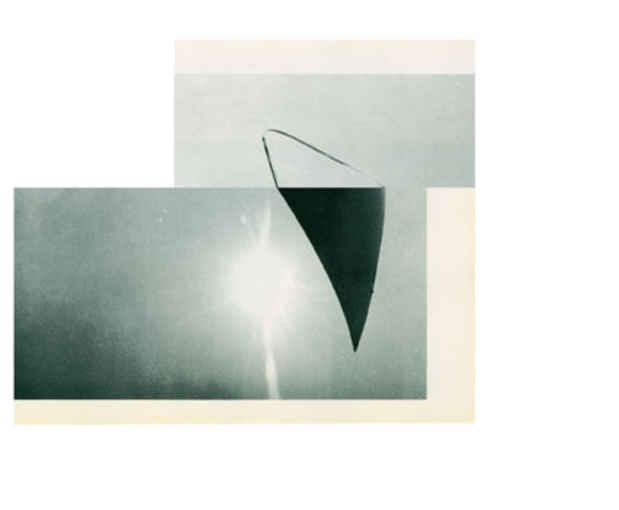Miriam Böhm, Rosy Keyser, and Erin Shirreff Exhibition
Lisa Cooley Fine Art

This event has ended.
The works of Miriam Böhm, Rosy Keyser, and Erin Shirreff, while formally and visually distinct, share a nuanced exploration of visual perception and the subjective excesses it enables. This tendency exists on a wide-ranging continuum between the three artists. In their own meticulous ways, they give the viewer multiple perspectives within a single work that gradually lends itself to a perceptual dislocation. In the works of Miriam Böhm this occurs more literally through photographic representations – multiple photographic vantage points and narrative spaces exist in a single frame. In Erin Shirreff’s collage works made from cut-out book pages, familiar yet mysterious sculptures of unknown provenance are bifurcated and reassembled, creating a new image that intimates a visually cohesive object that never quite arrives. Meanwhile Keyser’s large abstract paintings and sculptures negotiate perspective through their hands-on materiality – paint is utilized as a sculptural material, making the works simultaneously function as abstract landscapes and representational forms. Shared forms of gesture and engagement also unite these varying aesthetic strategies. Even as each artist’s works in the exhibition provide divergent singularities, the larger dialogue concerns the perceptual vagaries that gradually emerge.
On the continuum of disorientation shared among the three, the photographs of Miriam Böhm sit on the furthest end of the scale. Her photographic works compile multiple images into a singular yet complex narrative space. While the individual scenes may be casually familiar – a hand in the act of painting an abstract composition – their larger context becomes increasingly inexplicable as one slowly deciphers the works’ construction. In a carpeted space that recalls a contemporary office, two slightly similar images stand at varying distances; the shallow depth of the narrative space and the uncertain scale of the images disrupt the viewer’s perspective. The painter’s hand shown in several of the images further complicates this perceptual vertigo – is the image in fact a painting, or a photograph of a painting? The images speak to matters of perception but also the nature of reproduction, process, and repetition. While artists have previously created such photographic multilayered collages, Böhm’s work is distinct in so far as it is not exclusively an endless re-appropriation but an organic composition of overlapping peripheries: In the absence of a stable center is a rhizomatic collection of margins that while deeply cerebral, is sumptuously rhythmic as well. Böhm is less concerned with creating a visual compositional puzzle than with transcending perspective by presenting multiple and fluid vantage points.
In Erin Shirreff’s work—whether photographs, video, or sculpture—there is an overt subtlety that belies a complex meditation on perception and meaning. Like Böhm, her work pivots on the use of deceptively mundane images, materials, and objects, but here the work is always revolving around a single thing, which through a plainspoken, pared-down presentation resonates with a deeply felt blankness or generality. Pages, a new series of collages in the exhibition, are made of conjoined black-and-white reproductions of early and mid twentieth-century sculpture. Their very evident, simple construction plays against the visual coherence of the assembled forms as they slide back and forth between representation and abstraction. This perceptual syncopation and misidentification provokes the viewer’s desire for what is, arguably not actually, missing. The collection of sculptures in the exhibition – forms made of pigmented gypsum and cement – similarly trade on what is absent. Silhouettes of abstract, geometric forms and two-dimensional shapes hover in a temporally ambiguous zone, appearing both made and found. The effectiveness of Shirreff’s conceptual concerns hinges on her selection of subjects that are familiar to the point of becoming enigmatic, leaving us to grapple with how meaning is created in an anonymous visual landscape.
If Böhm and Shirreff use repetition or familiarity to develop perceptual ambiguity, the paintings and sculptures of Rosy Keyser achieve this through their sprawling and exploratory impermanence. Categorically abstract, her large and often imposing paintings are highly intuitive and materially contingent – the artist herself has described them as ‘Neo-Brut.’ Just as Bohm and Shirreff utilize relatively basic materials – cardboard, ash, bubble wrap, industrial plaster – Keyser’s paintings are assemblages of everyday objects and enamel house paint. The use of these materials manages to turn their narrative plane inside out, pushing them into a representational collage. Pieces of canvas stretch and wrinkle while being coated with thick layers of enamel, as paint becomes raw material. As emotionally opaque as some of the works seem, their turbulent exploration of the materials reveal the artist working on a balance beam. Keyser’s storm-and-stress romanticism emphasizes process and perspective over the aura of the eternal that underlies the more orthodox expressions of abstract painting. The result is a prismatic space where abstraction becomes immanently concrete.
Media
Schedule
from June 27, 2011 to August 12, 2011
Opening Reception on 2011-06-26 from 18:00 to 20:00